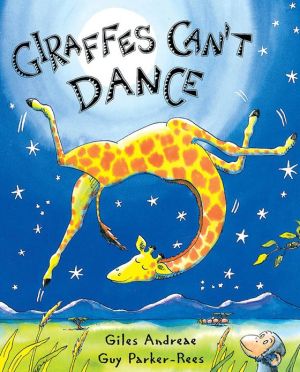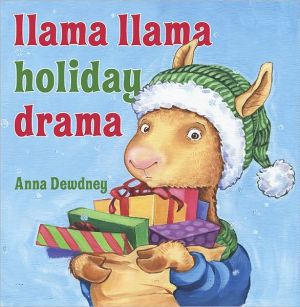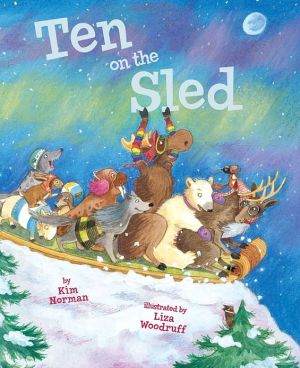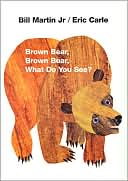Giraffes Can't Dance
Gerald the giraffe longs to dance, but his legs are too skinny and his neck is too long. His knees buckle whenever he tries to twirl. At the Jungle Dance, the warthogs waltz, the chimps cha-cha, and the lions tango. "Giraffes can't dance," they all jeer when it's Gerald's turn to prance. But there is one little creature who believes in Gerald. "Everything makes music," the cricket explains, "if you really want it to." So Gerald starts swaying to his own sweet tune.\ With light-footed rhymes...
Search in google:
Gerald the giraffe longs to dance, but his legs are too skinny and his neck is too long. At the Jungle Dance, the warthogs waltz, the chimps cha-cha, and the lions tango. "Giraffes can't dance," they all jeer when it's Gerald's turn to prance. But with some sound advice from a wise cricket, Gerald starts swaying to his own sweet tune.Publishers WeeklyAll the jungle's got the beat, but Gerald the giraffe has four left feet. Such is the dilemma in this British team's bouncy if didactic picture book about self-esteem. As a multitude of fleet-footed beasts eagerly "skip and prance" at the annual Jungle Dance in Africa, Gerald feels sad "because when it comes to dancing/ he was really very bad." Jeered by waltzing warthogs and cha-cha-ing chimps when he attempts to cut a rug, Gerald hangs his head and leaves the celebration behind. Luckily, a friendly cricket appears in the moonlight, chirping a morale-boosting song of self-confidence that soon sets Gerald in graceful motion. Andreae's rhyming text has a jaunty rhythm that's likely to spark interest in the read-aloud crowd, in spite of a heavy-handed message. Parker-Rees's kicky depictions of slightly anthropomorphic animals boogying on the dance floor are the highlight here. His watercolor and pen-and-ink artwork exudes a fun, party vibe. Ages 3-6. (Sept.) Copyright 2001 Cahners Business Information.
\ From Barnes & NobleGerald the Giraffe is a charming happy gent who has one aspiration -- to dance. The extra-tall giraffe is a bit wobbly in the knees, and his every attempt to boogie results with Gerald on the ground. It's time for the annual Jungle Dance, where all the creatures of the kingdom shake their respective tails. The lions dance the tango, and the chimps cha-cha-cha. As Gerald nears the dance circle, the animals snicker, "Hey, look at clumsy Gerald. Giraffes can't dance, you silly fool!" Sad and embarrassed, he retreats to his home. On the way, he bumps into a compassionate cricket who suggests that "Sometimes when you're different you just need a different song." So Gerald takes a new approach to dancing, as he listens to the wind in the trees and the swaying grass. And soon, with all the grace of a swan and the fancy moves of a pro, he dances for his jungle friends, who watch in astonishment. \ This amazing tale offers keen advice and adorable illustrations under the guise of a simple picture book. Illustrator Guy Parker-Rees perfectly portrays Gerald's frustration and humiliation over his supposed inability to dance. And the scenes in which the other denizens of the forest cut a rug will have kids rolling in the aisle -- it's not every day that you see two warthogs waltzing! Author Giles Andrews mixes rhyming text and simple language to create a strong message about individuality and the power of dancing to the tune of a different drummer, a lesson that makes this glorious picture book perfect for children and adults.\ \ \ \ \ \ From the PublisherAndreae's ode to a different drummer stumbles when it preaches about uncovering your own beat, but is ferned along by enough sweet verse and Parker-Rees' dazzling colors that it almost pulls its own weight. Gerald the giraffe's legs are too spindly for dancing, they are always buckling at the knees when it comes to the old soft-shoe. And while all the other creatures show some mean moves at the Jungle Dance ("The chimps all did a cha-cha/with a very Latin feel,/and eight baboons then teamed up/for a special Scottish reel"), poor Gerald is hooted off the dance floor before he even has a chance to crumple. As he shuffles homeward, and as he stopes to admire the moon, a cricket suggest that "just need a different song." So, to the sound of the wind in the trees, Gerald starts to move: a gentle swaying, some circling, ans some swishing. Suddenly he commences to belt out Olympic-quality gymnastic moves--"Then he did a backward somersault/and leapt up in the air"---that blows the other animals away. But probably not readers, even the youngest of whom will want to know just why Gerald's legs didn't buckle this time, special music or not. Bad enough that in a story about rhythm, the verse doesn't always scan--but mus Gerald srike the Travolta pose? Gerald doesn't find himself, he simply learns how to mimic.\ ---Kirkus Reviews, July 1st 2001\ All the jungle's got the beat, but Gerald the giraffe has four left feet. Such is the dilemma in this British team's bouncy if didactic picture book about self-esteem. As a multitude of fleet-footed beasts eagerly "skip and prance" at the annual Jungle Dance in Africa, Gerald feels sad "because when it comes to dancing/ he was really very bad." Jeered by waltzing warthogs and cha-cha-ing chimps when he attempts to cut a rug, Gerald hangs his head and leaves the celebration behind. Luckily, a friendly cricket appears in the moonlight, chirping a morale-boosting song of self-confidence that soon sets Gerald in graceful motion. Andreae's rhyming text has a jaunty rhythm that's likely to spark interest in the read-aloud crowd, in spite of a heavy-handed message. Parker-Rees's kicky depictions of slighly anthropomorphic animals boogying on the dance floor are the highlight here. His watercolor and pen-and-ink artwork exudes a fun, party vibe.\ --Publishers Weekly, September 10th, 2001\ A clumsy giraffe is instantly transformed into an exceptional dancer when he finds music that he loves. Gerald has tall, thin legs, which are good for standing still, but when lie tries to run, his crooked knees buckle. At the annual Jungle Dance, lie is laughed off the floor. A cricket tells him that "...sometimes when you're different you just need a different song." This advice enables the lonely creature to dance, much to the amazement of the other animals. The rhythmic text follows a pattern of four lilies per stanza. Some rhyme and others do not. Some flow smoothly; others are forced. One line states that, "He threw his arms out sideways. - - ." Huh! Giraffes don't have arms. Full-page color illustrations done in pen and ink and watercolor are bold and warm. Characters are whimsical and expressive, but they don't make up for the drastic and unbelievable turnaround that takes place upon hearing the cricket play his violin. For stories about individuality, stick with Helen Lester's Tacky the Penguin (1988) and Three Cheers for Tacky (1994, both Houghton) or Robert Kraus's Leo the Late Bloomer (HarperCollins 1971) and Owliver (Prentice-Hall, 1974; o.p.).\ ---School Library Journal, October 2001\ \ \ \ Publishers WeeklyAll the jungle's got the beat, but Gerald the giraffe has four left feet. Such is the dilemma in this British team's bouncy if didactic picture book about self-esteem. As a multitude of fleet-footed beasts eagerly "skip and prance" at the annual Jungle Dance in Africa, Gerald feels sad "because when it comes to dancing/ he was really very bad." Jeered by waltzing warthogs and cha-cha-ing chimps when he attempts to cut a rug, Gerald hangs his head and leaves the celebration behind. Luckily, a friendly cricket appears in the moonlight, chirping a morale-boosting song of self-confidence that soon sets Gerald in graceful motion. Andreae's rhyming text has a jaunty rhythm that's likely to spark interest in the read-aloud crowd, in spite of a heavy-handed message. Parker-Rees's kicky depictions of slightly anthropomorphic animals boogying on the dance floor are the highlight here. His watercolor and pen-and-ink artwork exudes a fun, party vibe. Ages 3-6. (Sept.) Copyright 2001 Cahners Business Information.\ \ \ \ \ Children's LiteratureEvery animal at the African Jungle Dance sneers at poor Gerald the giraffe when it is his turn to perform. The chimps did a brilliant cha-cha, the warthogs waltzed beautifully, and the rhinos rocked and rolled, but clumsy Gerald's knees buckle and his legs twist so he flees the party in shame. While admiring the beautiful moon, a friendly cricket offers hope to the despondent giraffe. "Listen to the swaying grass/ and listen to the trees./ To me the sweetest music/ is those branches in the breeze." While the cricket fiddles, Gerald learns to listen to the music that surrounds him. With bouncy breezy rhymes and vivid watercolor, pen and ink illustrations, young children are sure to be inspired by this heart-warming tale. A class of first graders loved hearing the story and viewing the colorful pictures. A lively discussion focused on values, dreaming and attaining success. 2001, Orchard Books, $15.95. Ages 4 to 8. Reviewer: Laura Hummel AGES: 4 5 6 7 8\ \ \ \ \ School Library JournalPreS-K-A clumsy giraffe is instantly transformed into an exceptional dancer when he finds music that he loves. Gerald has tall, thin legs, which are good for standing still, but when he tries to run, his crooked knees buckle. At the annual Jungle Dance, he is laughed off the floor. A cricket tells him that "-sometimes when you're different you just need a different song." This advice enables the lonely creature to dance, much to the amazement of the other animals. The rhythmic text follows a pattern of four lines per stanza. Some rhyme and others do not. Some flow smoothly; others are forced. One line states that, "He threw his arms out sideways-." Huh! Giraffes don't have arms. Full-page color illustrations done in pen and ink and watercolor are bold and warm. Characters are whimsical and expressive, but they don't make up for the drastic and unbelievable turnaround that takes place upon hearing the cricket play his violin. For stories about individuality, stick with Helen Lester's Tacky the Penguin (1988) and Three Cheers for Tacky (1994, both Houghton) or Robert Kraus's Leo the Late Bloomer (HarperCollins, 1971) and Owliver (Prentice-Hall, 1974; o.p.).-Kathleen Simonetta, Indian Trails Public Library District, Wheeling, IL Copyright 2001 Cahners Business Information.\ \ \ \ \ Kirkus ReviewsAndreae's ode to a different drummer stumbles when it preaches about uncovering your own beat, but is ferried along by enough sweet verse and Parker-Rees's dazzling colors that it almost pulls its own weight. Gerald the giraffe's legs are too spindly for dancing; they are always buckling at the knees when it comes to the old soft-shoe. And while all the other creatures show some mean moves at the Jungle Dance ("The chimps all did a cha-cha / with a very Latin feel, / and eight baboons then teamed up / for a special Scottish reel"), poor Gerald is hooted off the dance floor before he even has a chance to crumple. As he shuffles homeward, and as he stops to admire the moon, a cricket suggests that "you just need a different song." So, to the sound of the wind in the trees, Gerald starts to move: a gentle swaying, some circling, and some swishing. Suddenly he commences to belt out Olympic-quality gymnastic moves-"Then he did a backward somersault / and leapt up in the air"-that blows the other animals away. But probably not readers, even the youngest of whom will want to know just why Gerald's legs didn't buckle this time, special music or not. Bad enough that in a story about rhythm, the verse doesn't always scan-but must Gerald strike the Travolta pose? Gerald doesn't find himself; he simply learns how to mimic. (Picture book. 3-5)\ \ \ \ \ Children's LiteratureA perfect marriage of rhyming text and whimsical illustrations, this board book invites young children to imagine their favorite zoo animal learning to dance. Adults reading this book to children will also enjoy the animals' antics as the lions tango and the rhinos rock and roll. The alliteration as well as the rhymes all makes a delightful volume to be enjoyed again and again. One imagines listening to music along with the story time opportunities. The anthropomorphic animals are clever and witty. The underlying message to children is that one should always try to do things and never be discouraged. Since music is the universal language, this could be read in tot music classes as well as at the library story hour. The text is imaginative and the illustrations are sure to please. Reviewer: Sandra Kitain\ \



![Tickle Monster Laughter Kit [With Tickle Mitts] Tickle Monster Laughter Kit [With Tickle Mitts]](/application/data/covers/98/35/9781932319835.jpg)



